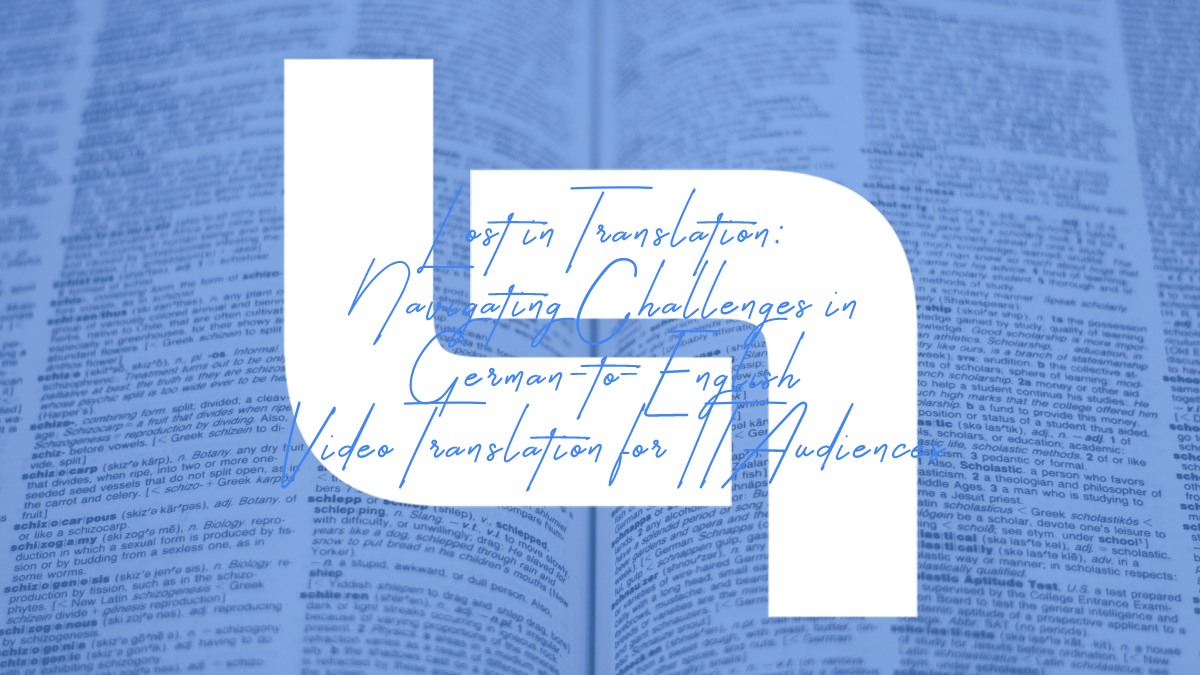Translating and translating video is no easy task. It requires specialized knowledge of both languages as well as an understanding of how each word can be interpreted differently depending on the context. As a result, there are many challenges that you might encounter when translating text into video. However, with the right tools and techniques at your disposal, you’ll find that it’s not as difficult as it may first appear! In this post, I will cover some of the most common issues faced by translators when working with English-to-German translations for IT audiences.

Lost in translation
The first step for a translator is to understand the context of the message. This means knowing what you’re trying to say and why you’re saying it in English instead of German.
Translators also need to know their audience who will be watching this video? What kind of people will they be? What do they expect from an IT translator? The answers will help inform how you translate your script so that it resonates with them properly.
The third factor is source language knowledge; this means understanding how words are used together in German and how that differs from English syntax and grammar rules (or lack thereof). You may want to read up on some common translation mistakes made by non-native speakers before starting work on your project so that you don’t accidentally make one yourself!
German-to-English translation
When you’re translate video german to english, there are some challenges that you need to be aware of. The German language is complex, and can present a number of difficulties for translators.
- German grammar is challenging: German words have many meanings, which makes it difficult for translators who aren’t familiar with the language or culture.
- Vocabulary is complex: Many words in German have multiple meanings; this means that there may be more than one way to translate a word into English based on context and usage within your industry.
- Words are long and descriptive: In some cases, this means that a single word could take up several lines on its own which can make things tricky when trying to fit everything into an allotted space (like an app). Consider whether your audience would benefit from seeing all those extra details highlighted or hidden behind links or buttons instead!
Video translation challenges
Video translation is a complex process that requires a thorough understanding of both languages. Not only do you have to translate words, but also the visual elements in the video. And not only do you have to translate language and cultural context, but also make sure that each side understands what the other is saying.
As mentioned above, this can be challenging for many reasons: First of all, there are many different styles of speaking from formal presentations to casual conversations and these often require different approaches when translating them into another language; secondly, there are also many different types of videos with varying degrees of complexity; finally (and perhaps most importantly), if something doesn’t sound right when translated from one language into another it’s very likely because some aspect wasn’t properly conveyed by either party during production or post-production processes!
IT audiences
IT audiences are a unique group of users. They are often very technical, preferring to communicate in their own language and jargon. They can be very demanding and have high expectations, as well as a low tolerance for any mistakes or mistakes made by others on your team.
IT users also expect to be able to understand the content without having to think about it they don’t want their minds bogged down with difficult-to-decipher language; they just want answers!
Communication barriers
Communication barriers can be the most difficult to overcome. They include language barriers, cultural differences and political concerns. Language is the most obvious barrier of all and one that often goes unacknowledged because we take it for granted that everyone speaks English (or another common language). But even if a speaker knows your language, there may still be difficulties:
- If your audience uses a different dialect from yours, they might not understand what you’re saying unless you use specific words or phrases from their dialect. For example, people who live in New York City have different ways of talking than people who live in rural areas like Kansas or Minnesota and even within New York City itself! This can affect how people interpret what’s being said at any given time; if someone doesn’t understand what someone says because he/she doesn’t know their “New York” slang terms (“the city”), then there’s going to be some trouble communicating back-and-forth effectively between both parties involved while working together towards completing tasks together as part of an overall team effort towards achieving its goal(s).
Multilingual content
A challenge of multilingual content is that it requires a translator who is native in both languages, or at least fluent in both. If this is not the case, your translation may be lost in translation.
In addition to requiring a translator who can translate between two languages, you’ll also need one who has experience with your subject matter. For example, if you’re creating an IT video for German audiences and want it translated into English for those same audiences (or any other audience), then having someone experienced with IT terminology would be helpful because they will know how best to translate such terms into another language without losing their meaning or context for example “die Festplatte” becomes “hard drive” instead of simply “disk drive” or some other phrase that doesn’t mean what your intended audience expects when they hear “Festplatte.”

Conclusion
As you can see, there are many challenges involved in translating video content from German to English. But with the right translation agency and a clear understanding of your goals, you can make sure that your video reaches its intended audience.

